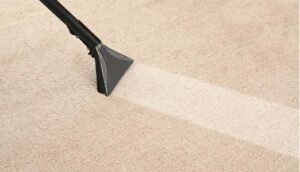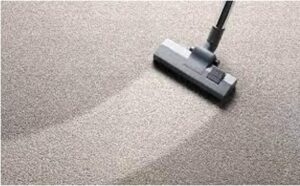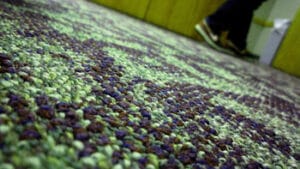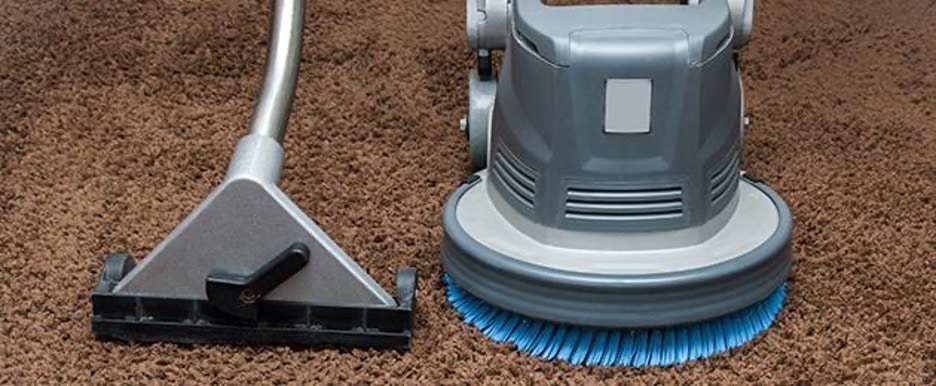It’d certainly make things much easier if carpets weren’t so prone to dirt, dust, and debris, but sadly, they are. For that reason, you might either decide to clean your carpet yourself or get your carpet cleaned professionally, which is the best carpet cleaning method.
Either way, you need to know that carpet fibres are made differently, in turn, requiring different types of carpet cleaning methods. Therefore, you need to conduct research and distinguish between the suitable methods along with their advantages, disadvantages, necessary equipment, and cleaning solutions for your carpet.
In this article, we’ll answer all your questions about the top 5 carpet cleaning techniques.
The Short Answer
|
Carpet Cleaning Method |
Use |
Drying Time |
|---|---|---|
|
Hot Water Extraction |
Commercial and domestic |
240 to 300 minutes |
|
Dry Powder Cleaning |
Commercial |
15 minutes |
|
Encapsulation Cleaning |
Commercial |
60 minutes |
|
Bonnet Cleaning |
Commercial |
30 minutes |
|
Dry Foam Carpet Cleaning |
Commercial |
240 minutes |
The 5 Best Ways to Clean Your Carpets
Here’s a detailed explanation of the best carpet cleaning methods employed by carpet cleaning services.
- Hot Water Extraction Carpet Cleaning
- Dry Powder Carpet Cleaning
- Encapsulation Carpet Cleaning
- Bonnet or Dry Cleaning Carpet
- Dry Foam Carpet Cleaning
Also known as steam carpet cleaning or steam rug cleaning, hot water extraction carpet cleaning is ideal for commercial and domestic carpet cleaning (at a hotel or home).
Pressurized hot water extraction cleaning employs high-quality deep cleaning technology and extracts dirt particles deep into the carpet. It’s one of the most famous and used methods during which professional cleaners steam clean carpets with the support of state-of-the-art technology.
On the downside, steam cleaning requires a lot of water, which means that the carpet takes longer to dry than we would’ve liked. And of course, the excessive amount of water may damage your carpet, sometimes even beyond repair, when soaking deep into the carpet pad.
To elaborate, this carpet cleaning extraction method takes about 2 to 3 hours for an average-sized carpeted office. However, we’re talking about at least 4 or 5 hours of drying time. So, when we say this method is time-consuming, it still won’t take more than 8 hours total, which shouldn’t be an issue for a home carpet.

Tip: Washing carpets in the afternoon is preferable because then you can leave them to dry overnight so that office work won’t be interrupted.
Still, steam carpet cleaning can be beneficial as long as you do it right and don’t overuse it, and the trick to quality steam cleaning is using a steam cleaning device with high heat levels and suction levels.
For steam cleaning methods, a mixture of high-temperature water (about 250-degree Celsius) and natural cleaning agents is used and pumped into your carpet at high pressure. High pressure is essential because it dissolves or loosens debris, soil, and stains from your carpet’s fibres.
Soap is applied to the soiled carpet surface, and its surface is agitated using brushes. After, the hot water extraction cleaning or steam cleaning carpet device comes into play with its two tanks: a solution tank and a recovery tank. The solution tank is for the clean water, whereas the recovery tank is for the extricated dirty one.
This steam cleaning machine works a cleaner and hot water solution into your carpet, and then its powerful suction extracts the cleanser with as much debris as possible. Hence, the vacuum cleaner is sure to suck the dirty water and soil from your carpet and eliminate bacteria, odours, and dust mites.
These rug steam cleaning machines rinse the carpeting, which you’re then required to leave at room temperature or air-conditioned temperature to dry for the time we’ve detailed previously.
Dry powder cleaning or compound cleaning is by far the quickest, latest, and most popular way of cleaning a carpet. Not only is it growing increasingly popular by the day, but it’s also getting the thumbs up of leading carpet manufacturers.

Since dry powder cleaning allows carpets to dry in no time, this is perfect for regular cleaning. It’s also a suitable method for commercial use (such as in hotels), removing dirt without a deep clean.
For this method, the host system technique is used. First, you’ll have to create a mixture of a soft and natural cleaning product, detergent, a bit of water, and a safe-to-use solvent, or you can simply get a special carpet dry cleaning powder. If you’re dealing with a heavily soiled carpet or dry powder, laminate your mat with a pre-spray.
Some companies use fully synthetic powders or an all-natural compound made of dried and ground corn cobs for deeper cleaning. They may add different cleansers (like an oxygenator cleanser). These may make your carpet wet for a short while, but the oxygenated bubbles attract dirt embedded deep into the carpet.
Then, you can sprinkle the mixture on the base part of your carpet using a counter-rotating brush machine. These brushes are cylindrical with clusters of nylon bristles, and their stiffness varies according to your carpet’s type.
To agitate the rug dry cleaning powder, the brush is used in a North/South followed by an East/West direction, and this movement ensures that the carpet fibres are clean from all sides. The process should help form lumps that resemble sawdust and act as micro-sponges, dissolving and attracting the dirt automatically.
After leaving it for a proper amount of time (about 15 minutes in all environments except humid ones), you can then vacuum these sawdust-like lumps off your carpet, leaving it nice and clean.
Tip: Try to maintain good air circulation in your home or office using a ceiling fan or an HVAC unit for an optimal drying environment.
Yet another dry carpet cleaning method has taken carpet shampooing technology by storm, which is encapsulation carpet cleaning. Like dry powder cleaning, encapsulation cleaning is well-suited for commercial professional office use and saves you some downtime.

Moreover, froth encapsulation is one great option for people pursuing eco-friendly products because the carpet cleaning process causes less chemical residue than in carpet shampooing (which we’ll get to later).
The carpet is ready for use shortly after being cleaned thanks to its low-moisture system, and the floor is clear of chemicals afterwards. Its drying time is certainly shorter than that of regular carpet shampooing, and it also uses significantly less water.
Before proceeding with the cleaning, the carpet cleaners need to vacuum the carpet. Then, they place a specialized applicator, cylindrical device, a compression sprayer, or a rotary floor machine onto your carpet with a synthetic detergent used as a base.
The tool releases this detergent, an encapsulation carpet cleaning solution, which creates foam. When the applied foam dries, the loosened dirt is encapsulated into a powder. Consequently, the dirt on your carpet is absorbed and isolated. And the vacuum can help suck up the polymer and dirt crystals for some deep cleansing.
In the past, this encapsulation carpet cleaning process was deeply flawed, as the residues in your carpet attracted dirt, and so carpets would start resoiling shortly after being cleaned. Thankfully, resoiling is no longer an issue because the bond formed between the polymer or dirt crystals and the carpet fibres is so weak that they break away with no difficulty.
This cleaning system gives your carpet a deep clean, removing the soil deep into it. The result is a clean and hygienic carpet. Nonetheless, it isn’t equipped to clean heavy soiling carpets thoroughly. For that, we’d suggest you look into carpet shampooing.
Despite its name, dry rug cleaning is, in fact, not a dry cleaning process. It’s a low moisture process where the surface of the carpet is treated. It only tackles the surface (about ⅛ of an inch deep into the carpet), which has several implications.

On the one hand, the carpet dries in 30 minutes, and this quick fix makes it common in hotels and residential building. On the other hand, it won’t get to the dirt residing under the carpet’s surface level, not with the pressure applied by the cleaning device’s spinning pad on the mat, leaving residue behind. This will resurface shortly, and the carpet will get soiled once again.
Consequently, carpet dry cleaning method is best used for a relatively thin carpet. And be careful because this may not work on some other carpet types, instead damaging the pile and embedding the dirt deeper into the carpet rather than removing it.
Therefore, this Bonnet method carpet cleaning is understandably not high on our list or the most effective, but it’s there for a reason. It’s another excellent option for commercial use, as it’s a fast carpet cleaning method that gives the carpet a clean and fresh look.
This process is composed of two necessary carpet cleaning methods. Firstly, an absorbent pad (dry cotton bonnet) is immersed in a cleaning agent or solution, which functions to absorb dust and wipe out stains.
The professional carpet cleaners make use of high-moisturized and heavy motorized equipment. They blend cleaning products and carbonated water and spray this self-neutralizing detergent onto the carpet. They use a rotary scrubber with the attached absorbent spinning pad to ruffle the carpet fibres so that the pad would absorb the soil on top of the carpet.
Tip: If you plan to use the bonnet carpet cleaning method, we’d suggest applying an antimicrobial agent on your carpet afterwards for proper sanitization.
Dry foam carpet cleaning is a combo of the dry cleaning method and the shampoo method (which we’ll discuss shortly). It’s a very effective method, and it’s best used on tough carpets due to the type of vacuuming and foam nature it involves.

Like the dry cleaning technique, it can be implemented by applying cleansing foam and a bit of water to the carpet by a professional carpet cleaner. This foam works to bond to harmful fibres and the likes.
It also shares an affinity to shampooing in its reliance on the aggressive brushing movement, typically a counter-rotating cylindrical brush action. But it differs from it in that the solution is whipped to help create a foam and applied to the carpet in that state rather than a liquid state.
Afterwards, the foam, along with everything it has attracted, gets extracted, leaving your carpet as good as new.
Honorable Mentions
It just so happens that there’s more than one carpet cleaning technique that didn’t make the cut, but still, you might like to be informed about them.
Carpet Shampooing

Shampooing a carpet was admittedly the first choice for most people until encapsulation technology took over in the 1970s. Currently, it’s the least effective of the carpet cleaning methods. Nevertheless, it cleans heavily soiled carpets, which is why it stands out from other carpet cleaning methods.
Regardless, we’ll walk you through its process and let you decide for yourself. A carpet cleaner puts formulated detergents directly onto the carpet. Then, they work their way through the mat with a cleaning machine. They scrub the formula or carpet shampoo on your carpet with a brush in a foaming technique, which agitates the cleanser.
To extricate the carpet shampoo and leftover soil, a vacuum cleaner is used, leaving your carpet looking clean and bright and smelling fresh. But before extrication, it’s vital to get the carpet dry.
Where carpet shampooing falls short is its lack of deep cleaning, meaning it doesn’t help with well-being and hygiene. That’s because it’s ineffective in the face of deeply embedded debris lurking within the carpet.
Another unfavourable side effect of shampooing is the lingering wet foam in the carpet. Not to mention, even after it dries, shampooing doesn’t involve any rinsing techniques, which causes your carpet to be sticky. Therefore, one can understand why it’s neither a favourite method nor is it on our list.
Still, carpet shampooing is a good choice if you want that fresh look in preparation for an event, for example. Guests will be walking all over your carpet, and maybe someone spills a drink or lemon juice; any accidents of this nature could happen, so the carpet will need cleaning after. Accordingly, you might save the deep clean for then, and a carpet shampooing will do for now.
Preconditioning

For preconditioning, a carpet cleaning service applies preconditioning agents to the carpet early on, giving them adequate time to bond with the soil. This is done to help these small particles loosen from the carpet fibres.
Still, you may have questions about which preconditioning agent you should use on the carpet’s fabric. Typically, alkaline solutions work best on synthetic fibre carpets. And a diluted acetic acid solution, among other mildly acidic solutions, works best on wool carpets.
How Do I Clean My Carpet Myself?
Firstly, you need to vacuum your carpet thoroughly in 3 different directions and remove the allergens out of the carpet pile.
Secondly, put ¼ cup salt, ¼ cup borax, and ¼ cup vinegar in a mixing bowl. You can apply the solution to each deep stain and the heavily soiled parts of the carpet. Leave the carpet for several hours, just enough to dry, and then use a vacuum cleaner to suck it.
Thirdly, you’re going to need a steam cleaner, which you can rent preferably new for better results. If not, clean up the machine a little.
Fourthly, don’t use carpet shampoo. Instead, fill up your machine with boiling water, as it’s effective in removing the grime from your carpet. You may add 1 cup white vinegar for every 2.5 gallons of water to get a deep clean for soiled carpets.
Fifthly, you need to press a button to release the hot water and release the button to extract it. The extraction should take ¾ of the time dedicated to the entire process. Afterwards, you can soak the carpet and dry it as good as you possibly can. Of course, you’d have to stop anyone from stepping on the carpet until it’s dry.
This sixth step is basically to repeat the previous steps for the best outcome.
Tip: If you’d previously removed any furniture from the area, you can put it back, but be sure to place aluminum foil under the furniture’s legs if you don’t want wood stain bleeding onto your carpets.Finally, try to get rid of the dirty water in the machine responsibly. If you’re not sure how, ask your local water treatment plant for help. In many cases, people who rent out their machines take them back full so that they’re sure the water isn’t being dumped down the drain, thus relieving you of that burden.
FAQs About Carpet Cleaning Methods
Steam cleaning (hot water extraction) is arguably the best carpet way to clean a carpet, as it cleans carpets of more than 90% of bacteria. However, if you’re looking for a quick fix for foot traffic, bonnet cleaning makes a solid choice.
We’d say it depends on your carpet’s state. If your carpet has many stains or heavy soil, carpet shampooing is your go-to method. As for carpets with no huge carpet stains, we urge you to steam clean them because this will help remove the bacteria within your carpet.
Generally, a professional carpet cleaning company relies on steam cleaning. Pumping water at boiling point and high pressure enable it to penetrate carpet fibers and loosen the bacteria clinging to it. Afterwards, the water is extracted with vacuuming.
To create the cleaning solution, add one part vinegar and 3 parts water. Submerge the scrub brush’s end in the solution. Then, run the brush over your carpet. Agitation can help you reach the carpet fibers, but don’t over-saturate the carpet. Finally, you can go over it with a cloth to get rid of the extra moisture.
A carpet cleaning service has the proper equipment to remove germs better and faster, and the drying time tends to be shorter than if you cleaned the carpet yourself.
The appeal of DIYing your way through this project is that it could save you money. However, if you’re going to rent a cleaning machine, you could find yourself spending a ton of money for average results.
Let’s Get Cleaning!
All in all, carpet cleaning is an experience, and it can be worth it. There’s a variety of carpet cleaning methodsexplained previously, and they all aim to get the job done, but the trick lies in using the suitable one.
Consider the carpet’s thickness and material, whether it has a big stain or stains, whether it’s heavily soiled, whether you want it deep cleaned or dry-cleaned, whether it’s in a domestic or commercial area, how much downtime you’re willing to give it, how the environment typically is, and similar.
These factors will help you decide on the type of cleaning that your carpet needs, along with the required machines, substances, and steps. Undoubtedly, carpet cleaning services have that kind of knowledge and will do the job for you.
If you’re going to DIY, calculate the overall cost beforehand and make sure it’s worth your time and effort. Let’s get cleaning!




